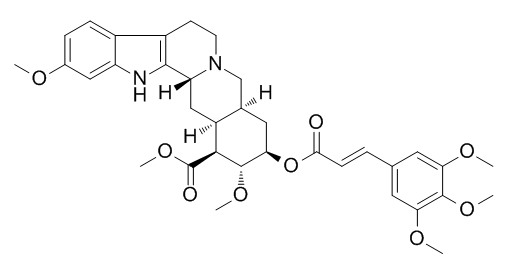Rescinnamine
Rescinnamine has anti-schistosomal activities.
Inquire / Order:
manager@chemfaces.com
Technical Inquiries:
service@chemfaces.com
Tel:
+86-27-84237783
Fax:
+86-27-84254680
Address:
1 Building, No. 83, CheCheng Rd., Wuhan Economic and Technological Development Zone, Wuhan, Hubei 430056, PRC
Providing storage is as stated on the product vial and the vial is kept tightly sealed, the product can be stored for up to
24 months(2-8C).
Wherever possible, you should prepare and use solutions on the same day. However, if you need to make up stock solutions in advance, we recommend that you store the solution as aliquots in tightly sealed vials at -20C. Generally, these will be useable for up to two weeks. Before use, and prior to opening the vial we recommend that you allow your product to equilibrate to room temperature for at least 1 hour.
Need more advice on solubility, usage and handling? Please email to: service@chemfaces.com
The packaging of the product may have turned upside down during transportation, resulting in the natural compounds adhering to the neck or cap of the vial. take the vial out of its packaging and gently shake to let the compounds fall to the bottom of the vial. for liquid products, centrifuge at 200-500 RPM to gather the liquid at the bottom of the vial. try to avoid loss or contamination during handling.
Food Sci Biotechnol.2024, 34(3):611-620.
Mol Med Rep.2015, 12(5):7789-95
Biochem Biophys Rep.2024, 40:101830.
Evid Based Complement Alternat Med.2017, 2017:7383104
Malaysian Journal of Analytical Sciences2022, 26(2):360-369.
Front Nutr.2023, 10:1168095.
Korean Journal of Pharmacognosy2014, 113-120
Front Endocrinol (Lausanne).2020, 11:568436.
Pharmacol Rep.2020, 72(2):472-480.
Nat Chem Biol.2018, 14(8):760-763
Related and Featured Products
PLoS Neglected Tropical Diseases, 2010, 4(7):e759.
Development and Validation of a Quantitative, High-Throughput, Fluorescent-Based Bioassay to Detect Schistosoma Viability.[Reference:
WebLink]
Schistosomiasis, caused by infection with the blood fluke Schistosoma, is responsible for greater than 200,000 human deaths per annum. Objective high-throughput screens for detecting novel anti-schistosomal targets will drive 'genome to drug' lead translational science at an unprecedented rate. Current methods for detecting schistosome viability rely on qualitative microscopic criteria, which require an understanding of parasite morphology, and most importantly, must be subjectively interpreted. These limitations, in the current state of the art, have significantly impeded progress into whole schistosome screening for next generation chemotherapies.
METHODS AND RESULTS:
We present here a microtiter plate-based method for reproducibly detecting schistosomula viability that takes advantage of the differential uptake of fluorophores (propidium iodide and fluorescein diacetate) by living organisms. We validate this high-throughput system in detecting schistosomula viability using auranofin (a known inhibitor of thioredoxin glutathione reductase), praziquantel and a range of small compounds with previously-described (gambogic acid, sodium salinomycin, ethinyl estradiol, fluoxetidine hydrochloride, miconazole nitrate, chlorpromazine hydrochloride, amphotericin b, niclosamide) or suggested (bepridil, ciclopirox, Rescinnamine, flucytosine, vinblastine and carbidopa) anti-schistosomal activities. This developed method is sensitive (200 schistosomula/well can be assayed), relevant to industrial (384-well microtiter plate compatibility) and academic (96-well microtiter plate compatibility) settings, translatable to functional genomics screens and drug assays, does not require a priori knowledge of schistosome biology and is quantitative.
CONCLUSIONS:
The wide-scale application of this fluorescence-based bioassay will greatly accelerate the objective identification of novel therapeutic lead targets/compounds to combat schistosomiasis. Adapting this bioassay for use with other parasitic worm species further offers an opportunity for great strides to be made against additional neglected tropical diseases of biomedical and veterinary importance.



